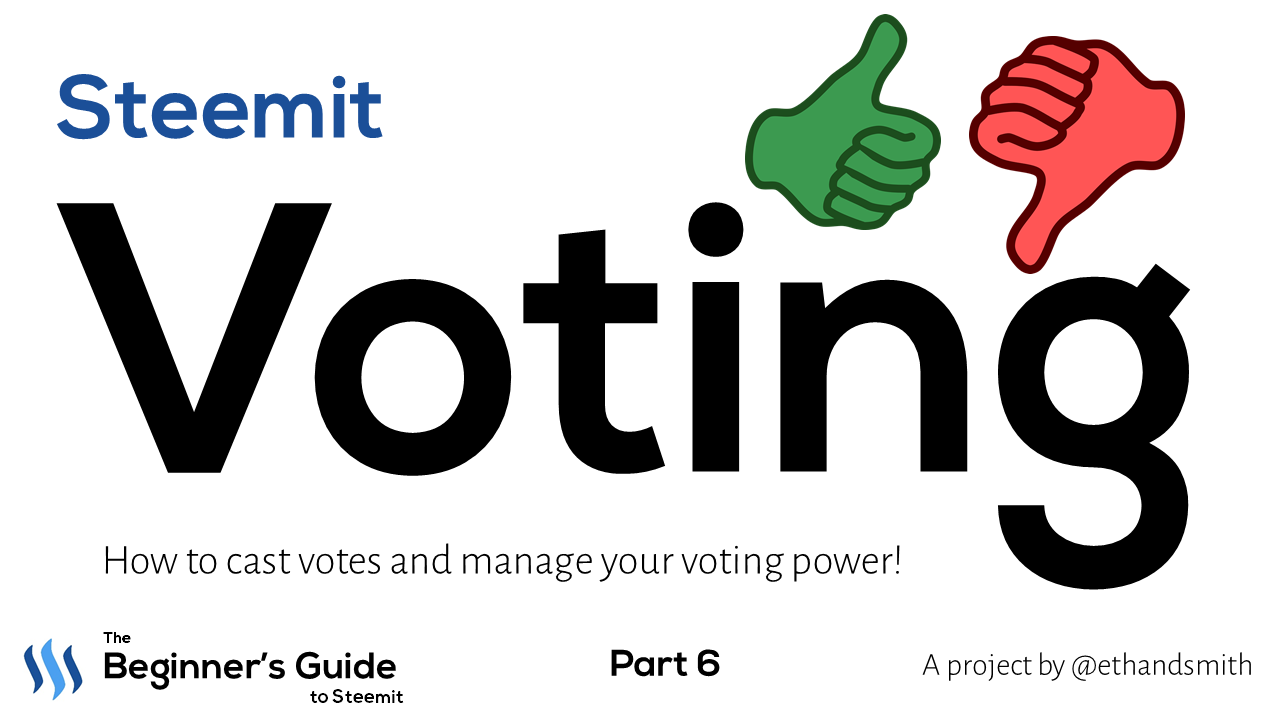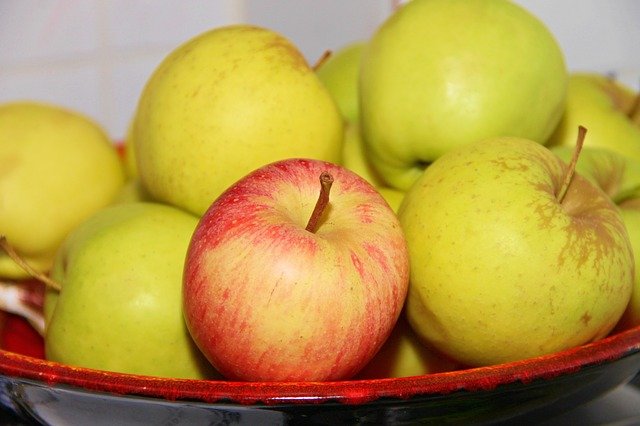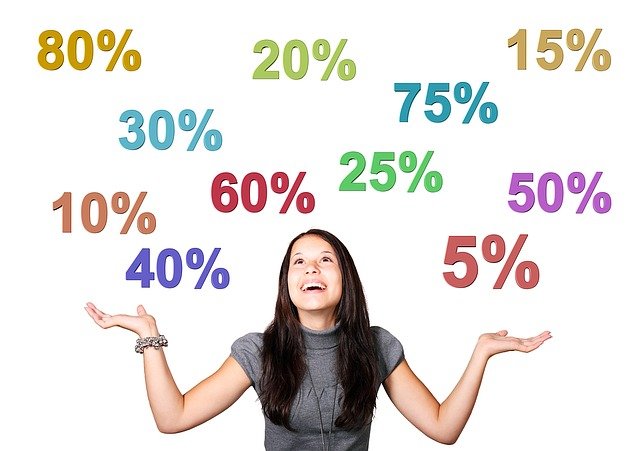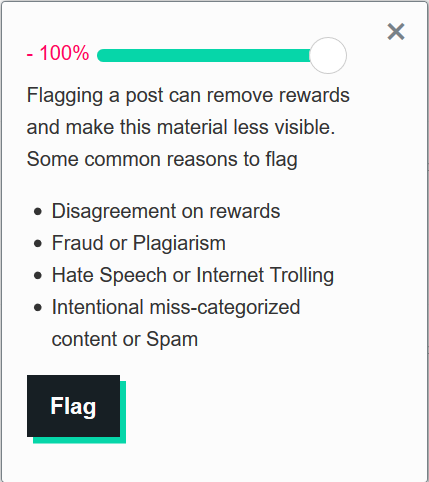Welcome to Part 5 of The Beginner's Guide to Steemit, a project seeking to demystify Steemit to brand new users and make joining the platform a seamless experience. If this is your first encounter with the Beginner's Guide, be sure to read previous installments:
- Introduction
- Part 1: Steemit Quick-Start Guide
- Part 2: Logging In and Keeping Your Account Safe
- Part 3: Steemit Currencies: STEEM, STEEM Power, and STEEM Dollars
- Part 4: Your Account's Wallet
- Part 5: Steemit's Social Functions
In the last lesson, you learned all about the social functions that your Steemit account may perform, with the exception of voting. We'll talk about voting in this lesson in detail so you will be an expert on voting in no time.

Image created by @ethandsmith using Nexa Bold and Alegreya Sans fonts and CC0 resources created by OpenClipart-Vectors Released under a CC0 1.0 Universal License.
Here's what you'll learn:
- How voting works
- Why voting power is important and how it affects your vote's value
- How voting power depletes and restores
- How voting strength is different than voting power
- How voting strength impacts voting power
- What a voting slider is and how to get one
- What downvotes/flags are and the purposes they serve
Voting

Image created by Wokandapix. Used under a CC0 1.0 Universal License.
Voting is one of the most important social function on Steemit since it is how users assign value to other users' posts, and how post authors receive reward payouts.
Learning how the voting system works can be one of the more challenging aspect of Steemit, but once you've mastered it, you'll have no problems at all seeking out and rewarding great content across the platform.
At the bottom of each blog post and comment, you'll see a small button:

This is the upvote button. It's what you click to show your approval of someone's post and to give the post rewards based on your SP. Keep this in mind as you read through this post. The value of your vote is always directly dependent on the amount of SP available to you. Votes on Steemit have value, unlike upvotes on Reddit, likes on Facebook and Instagram, and favorites on Twitter. However, before you go vote on every single post that you enjoy, you must understand the restrictions surrounding voting.
An Apple Analogy

Image created by manfredrichter. Used under a CC0 1.0 Universal License.
Consider a situation at a local fair. There is an apple-tasting contest and apple orchards from all over your region have come to participate. Each person who attends is allowed to vote on his or her favorite apples after trying them.
Imagine you love apples and you attend this competition. At the gate, you're given a set of ten tokens, labeled 1 through 10. These ten tokens may be used to cast votes on your favorite apples (one being the best, ten being your least favorite). You look around and see upwards of fifty different types of apples! What if they're all delicious?
Regardless, you are only allowed to vote for your ten favorite apples and rank them in order from your favorite (1) to least favorite (10). Therefore, you must use your tokens wisely.
You very carefully examine and savor each apple that you taste, knowing that only the ten best will receive one of your tokens, knowing that your lower-valued tokens will give the apples a better chance of winning the overall competition.
You also know that after you've used your tokens in this competition, you will be able to vote again the next time the competition comes around, so you can choose different apples then!
On Steemit, other user's posts are analogous to the apples.
Your votes are like the tokens. You want to reward the best apples, but you only have a set number of tokens and they are ranked so that your votes decrease in value as you go from 1 to 10.
Likewise, you want to reward the best posts with your votes. However, as you give votes, their value decreases slightly. The good news is, though, that your voting "strength" will replenish on Steemit, much like being rewarded a new set of tokens at the next apple competition.
Now that you've got the general idea, let's dive into how this looks on Steemit.
Voting Power (VP)

Image created by jplenio. Used under a CC0 1.0 Universal License.
In order to prevent everyone from bestowing unlimited rewards, Steemit has a restriction that is imposed on an account's ability to vote.
It's called voting power.
At any given moment, your account has a voting power statistic. This value, a percentage between 0 and 100%, does not appear anywhere on Steemit.com, so you must look elsewhere to find out what it is. Take a moment to browse over to Steemd.com.
Input your username by adding it to the URL as you would to browse to your blog on Steemit.
steemd.com/@yourusername
Look at the information that appears. In the top left corner of the page, you'll see several statistics. First, you'll notice your current amount of STEEM Power (SP). Beneath that value, you'll see a blue bar with a percentage on it. This is your account's voting power.

If you haven't yet cast a vote on Steemit, this bar will be at 100%. When you begin casting votes, you'll want to come back to Steemd.com to keep an eye on your voting power. Each time you cast a full strength upvote (we'll talk about voting strength in the next section), your voting power depletes by 2%. As your voting power decreases, so does the value that you are able to give to another post.
As an example, let's consider an account that has 500 STEEM Power (SP) and has full voting power. At the time this post was written, this user's full upvote would be worth around $0.12. If this user casts 5 votes on posts they like, this will lower their voting power by 10% to 90%.

At 90% voting power, a full vote from this user's account is now only worth $0.10.

This value will continue to decrease as voting power decreases (This example was calculated using @penguinpablo's Upvote calculator. If you'd like to try more examples, vary the voting power number on the calculator.)
How does VP replenish? It's easy to regain your voting power on Steemit. Simply don't vote on anything.
Voting power replenishes at a rate of 20% every 24 hours, so if you don't vote during that period, your voting power will return to 100%. Therefore, you'll find many people on Steemit who avoid giving more than ten full strength upvotes each day, since that depletes voting power down to 80% and allows recovery within the next day.
Ultimately, it is up to you to decide how much to vote. Keep in mind, though that the more you vote, the less your vote is worth. It's generally a good idea for new users to follow the ten votes per day rule. Once you begin voting regularly, there are several tools to use to keep track of your voting power to make sure you aren't getting carried away.
I've already mentioned Steemd.com, but you may also check SteemNow.com or SteemWorld.org. All of these sites have other features that help you with your account as well, and we'll talk about those in later lessons.
Voting Strength (or Percentage)

Image created by geralt. Used under a CC0 1.0 Universal License.
As a new user, chances are you won't need to worry about voting strength right away, but nevertheless, it is incredibly important for understanding how voting on Steemit works.
When you vote for the first time, you'll notice that after you click the upvote button, you might see small swirling graphic for a moment, and then the upvote button will turn solid green. This means you have given the post or comment an upvote.
Once your account reaches 500 SP, you'll notice a voting slider will appear after you click on the upvote button. The value shown on this slider is your voting percentage.


Voting percentage is another value from 0 to 100 that allows a user to use smaller portions of their voting power to give value to a post. This number is always independent of voting power, but the value given by any vote still depends on the overall voting power of an account.
Example
This can initially be a confusing concept, so let's take a look at an example using @penguinpablo's Upvote Calculator.:
Consider the user we discussed in the previous section who just arrived at 500 SP. He now has access to the voting slider, so he can change his voting percentage. He has waited since voting so that his voting power has recharged to 100%. Let's say he decides he wants to vote on a great post he just found, so he moves the slider to 50%. He will be voting at 50% voting strength with 100% voting power. This means his vote will be worth $0.06 instead of the $0.12 it was worth at 100% voting strength.

Remember that while a 100% vote depletes VP by 2%, a 50% vote would only deplete voting percentage by 1%. The amount of VP that depletes scales linearly with your voting percentage, e.g. a 25% vote would decrease VP by 0.5%, while a 1% vote would decrease VP by 0.02%, and so on. Therefore, you are able to give more low percentage votes each day than the ten if you always voted at 100% voting strength. This comes at the cost of the value you impart to the posts you vote on.
Play around with the Upvote Calculator to get an idea of how voting percentage and voting power impact your votes' values.
If you are using Steemit.com to cast votes (there are other sites you may browse the STEEM blockchain with, and we'll talk about them later, of course), as a new user you will always cast votes at 100% voting strength. However, like voting power, voting strength is a number that can vary between 0 and 100%.
So why do new users always cast at 100%, and how can you change this?
The short answer is that new users always cast 100% votes because of their low amount of SP. If you haven't invested any STEEM of your own into your account, you'll begin with a very low value of SP available to you in your account. This means that your vote will not be worth much at the beginning. Therefore, decreasing your voting percentage gives an even smaller amount of value to other posts.
The road to 500 SP may seem very long, but don't worry. There are plenty of ways to increase your SP. Begin by seeking out other users who have similar interests. Engage and vote on their posts, and they just might return the favor. There are also contests all across Steemit that may allow you to earn some STEEM or SBD much more quickly than getting votes. We'll discuss more about how to be successful in a later lesson.
For new users, I do recommend only giving ten votes per day when you start out. This allows you to give the maximum value possible to the posts and comments you choose to vote on.
Downvotes and Flags

Image created by johnthan. Used under a CC0 1.0 Universal License.
On Steemit, users are allowed to give downvotes to posts or comments in the same way as they give upvotes. Downvotes are synonymous with "flags" on Steemit. In the top right corner of any post or comment, you'll see a small flag symbol.
![]()
Flagging a post allows you to remove rewards instead of give them. The amount you may remove is based on your STEEM Power just like your upvote amount is. Here is the dialog that appears when you click the flag button:

First note the reasons Steemit lists as common flag reasons. While these are not the only reasons you may flag a post, they are some that are very important to the community. Several of these topics will be discussed in future lessons.
Flagging also will appear with a slider if you are above 500 SP just like the slider for upvotes. This means you may adjust the "magnitude" of the flag as you may with upvotes.
Be careful if you decide to flag a post, especially as a new user. Flagging has consequences on Steemit, so be prepared to have your content flagged as well. Flags from users with high SP may also lower your reputation significantly. Only flag if you are absolutely sure of your reasoning, and be prepared to answer for why you flagged should someone ask.
We will come back to flags when we discuss Steemit etiquette. A common alternative to flagging is thoughtfully expressing your disagreement or issue with a post in the comments. You have a chance to be rewarded for your thoughts, and the author of the post might be more apt to listen to your position.
Recap

Image created by 472301. Used under a CC0 1.0 Universal License.
There is a lot to learn about voting and flagging, so let's review the main takeaways:
- Votes allow users to express their approval of a post or comment
- Votes assign value to posts based on a user's STEEM Power
- New users vote at 100% by default on Steemit.com
- Upon achieving 500 SP, a user obtains a voting slider, which allows votes at different strengths
- Voting power depletes at a rate of 2% for every full strength (100%) vote
- Voting power replenishes at a rate of 20% per 24 hours
- Voting ten times at full strength each day is recommended for new users
- Flagging is a way to remove rewards on a post, but should be used thoughtfully
- Flags from users with high SP can lower reputation
I hope this has cleared up some of the mystery surrounding voting on Steemit. Be sure to let me know if you have any questions. Once you master voting, you'll be able to reward other users very effectively across Steemit.
There are many more topics to be covered, so stay tuned for more lessons in The Beginner's Guide to Steemit!



